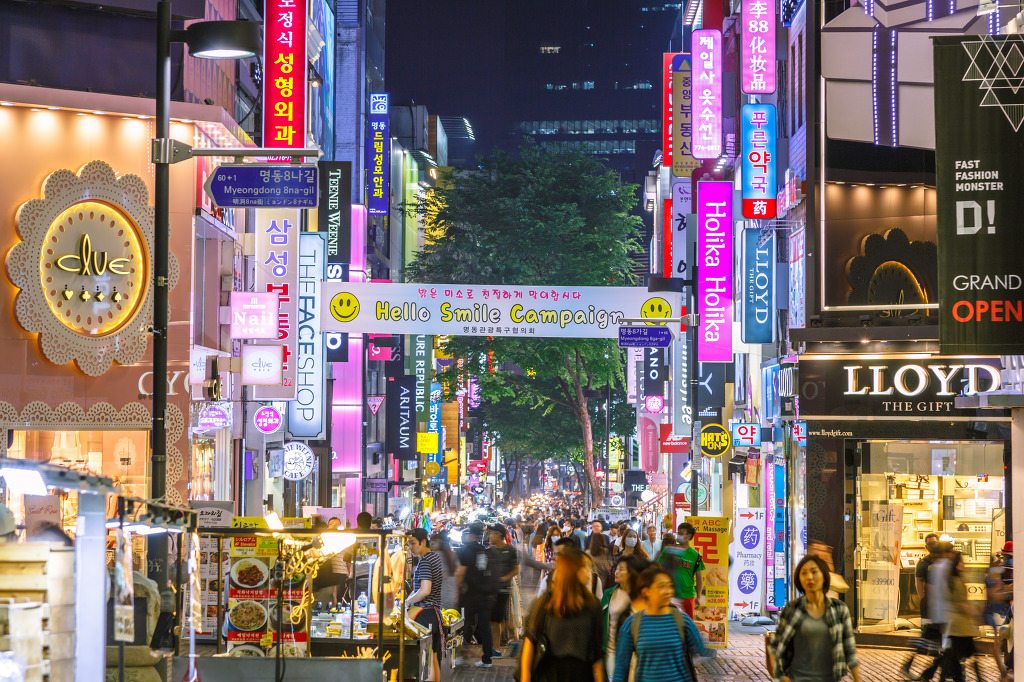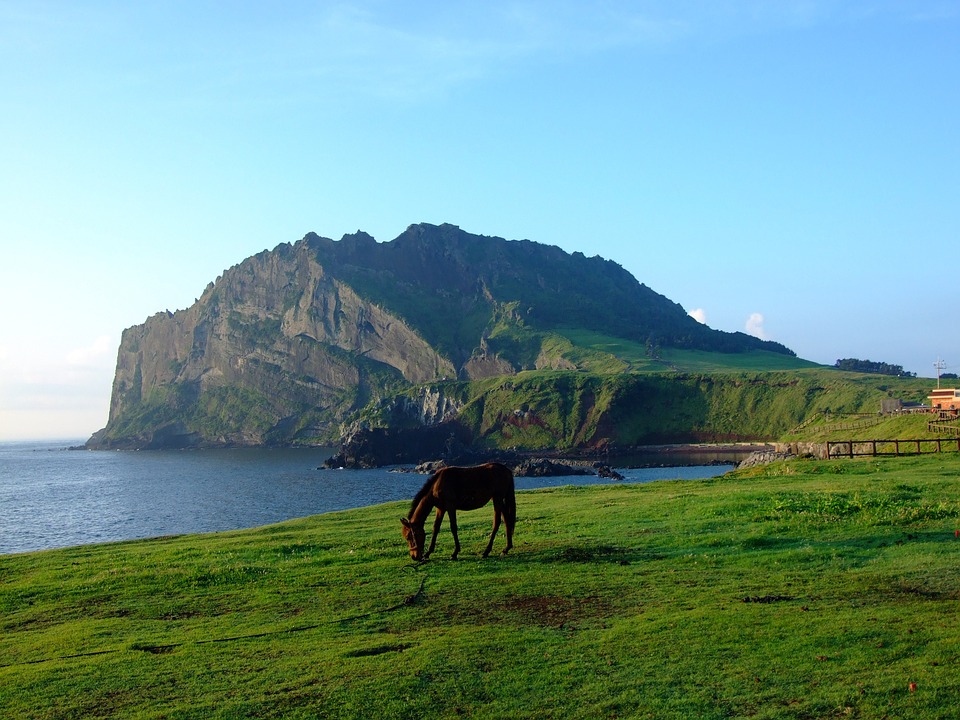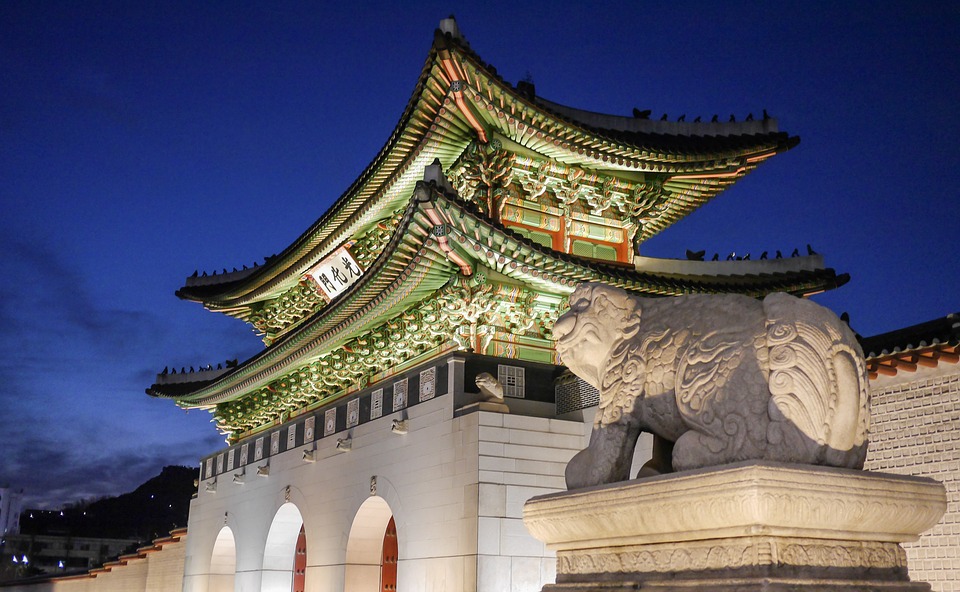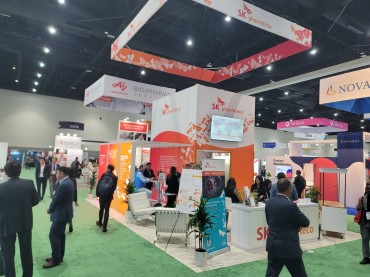
The South Korean government hopes to follow the cases of Japan and Taiwan which successfully overcame China’s sanctions on the tourism industry a few years ago over territorial and diplomatic disputes. Crowds tourist at the Myeong-Dong street night market with neon lights shop signs. The location is the premiere district for shopping in Seoul city. (Image credit: Kobiz Media/Korea Bizwire)
SEOUL, March 22 (Korea Bizwire) – South Korea’s tourism sector is moving to cope with the drop in the number of inbound Chinese tourists by moving to attract more locals and Southeast Asian visitors, industry sources said Wednesday.
The number of Chinese tourists, who accounted for roughly half of the 16 million foreigners who visited the country last year, dropped 21.9 percent on-year between March 1-19, according to the latest data released by the Ministry of Culture, Sports and Tourism.
The drop comes after the Chinese government banned the sale of tour packages to South Korea as part of retaliations against Seoul’s decision to deploy the Terminal High Altitude Area Defense (THAAD) system on South Korean soil.
Beijing has effectively suspended imports of Korean pop cultural content and shut down scores of Lotte outlets in China. Lotte has been targeted because it provided land for the THAAD battery.
Beijing insists the U.S missile defense system will undermine China’s security interests, although Seoul says it is to defend against North Korean provocations, not against China.
“It was high time for us to restructure South Korea’s tourism industry, as we’ve been complacent due to the influx of Chinese tourists,” Nam Sang-man, the head of the Seoul tourism Association, said. “It was not very profitable because despite the influx, a great number of Chinese tourists came here on cheap tour packages. We may actually earn more if we address inherent problems in our tourism industry,” he argued.

South Korea’s tourism sector is moving to cope with the drop in the number of inbound Chinese tourists by moving to attract more locals and Southeast Asian visitors. (Image courtesy of Yonhap)
Professor Kim Nam-jo of Hanyang University said, “An increase in the number of Chinese tourists visiting South Korea on luxury tour programs can offset the reduction in the total number, and such visits will eventually be helpful to the South Korean tourism industry on the whole.” The most urgent task facing the South Korean tourism industry is diversifying the nationalities of inbound foreign tourists, local analysts say.
Industry data show Chinese accounted for the bulk. People from Japan came in second with 13.3 percent of the total, trailed by the United States with 5.0 percent. The three countries made up 65 percent of all foreign tourists. This is different from other countries and needs to be fixed.
The ministry Wednesday announced plans to promote South Korea’s tourism industry abroad, including the establishment of Korea Tourism Organization branches in Mongolia and Kazakhstan and organizing tourism fairs in Singapore, Japan, Vietnam and India.
The government said it is taking steps to help increase the flights to and from Southeast Asian countries, Japan, Mongolia and Taiwan while allowing the issuance of electronic visas to Southeast Asian group tourists starting May.
Seoul will, moreover, permit five-day no-visa entry for Jeju-bound Southeast Asian tourists who transfer at South Korea’s Incheon or Gimhae airports.
“We are witnessing a growing number of South Asian tourists coming to South Korea recently,” said Hwang Myung-seon, a senior official in charge of tourism at the Ministry of Culture, Sports and Tourism.
“We are expediting the implementation of a number of tourism promotion packages during the first half of this year.” Provincial governments, meanwhile, have joined forces and are moving to reorganize themselves to be less dependent on Chinese visitors.
A group of 82 Japanese tourists arrived in the southeastern port city of Busan Wednesday on a ferry boat to join the city government’s coastline sightseeing program called the “Walking Galmaetgil Trails.” “We’ve launched the Galmaetgil trails program in association with Japan’s JR,” a city official said. “We are developing a variety of trail programs to help more Japanese tourists revisit Busan.”

The number of South Korean tourists who flew into Jeju for the first eight days this month rose 13.5 percent to 218,709, compared with 192,725 during the same period last year. (Image shows Jeju island/Pixabay)
The city’s Galmaetgil Trails are famous for the scenic coastal views in connection with Haeundae Beach and the 7.4-km Gwangandaegyo Bridge.
The government of South Chungcheong Province said it will join international tour expositions in Hong Kong and Taipei in the coming months to attract tourists, focusing on a variety of local festivals, scenic landscapes and cultural assets.
“We are trying to take advantage of the current situation to diversify our tourism market,” an official of the provincial government said, noting the province aims to hold a series of sessions in Malaysia, Thailand and Singapore in the latter half of the year to get people there more interested in South Korea and the province.
The South Korean government hopes to follow the cases of Japan and Taiwan which successfully overcame China’s sanctions on the tourism industry a few years ago over territorial and diplomatic disputes.
At that time, Japan and Taiwan turned to Southeast Asia to help revive their tourism industry, and the number of tourists from the region more than doubled in a relatively short period of time to offset dwindling Chinese visitors.
Taiwan witnessed a 16.1 percent reduction in the number of visiting Chinese tourists in 2016, but achieved a record number of foreign tourists with the total hitting 10.6 million. Meanwhile, the vacuum created by the declining Chinese tourists in the southern resort island of Jeju is being filled up by locals.
The number of South Korean tourists who flew into Jeju for the first eight days this month rose 13.5 percent to 218,709, compared with 192,725 during the same period last year, according to industry data.
Ko Seung-ik, an official of the tourism association on Jeju, said his association is currently marketing airfare to students for school excursions to take advantage of the decrease in Chinese tourists and to invite more tourists from Japan and Southeast Asian nations.
“It is true we were unable to fly additional flights for domestic tourists and those from other countries because the Jeju International Airport had been packed with airplanes carrying Chinese nationals,” he said.
Nearly 6,000 students from 20 schools across the country visited Jeju on excursion tours for the first three weeks this month, another official of the association said, noting an average of 40,000 domestic tourists are visiting Jeju on a daily basis in recent weeks.
“More and more students want to come to Jeju Island, as they are becoming aware of the difficulty the island’s tourism industry is facing due to the Chinese sanctions,” the official claimed.
Reservations of golf courses and condominiums reached a respectable 60 percent for the week ending on Sunday, according to data by the association. The comparable figures for rental cars, hotels and pensions are 49 percent, 48 percent and 46 percent each. The head of a private tour agency, who identified himself by his family name Chung, said business grew more than 30 percent last month from a year earlier.
An employee of another tour agency said a larger number of local tourists are coming to Jeju in recent weeks to enjoy the original serenity of the island which had been swamped by Chinese tourists in the past few years.
Related to the diplomatic row with China, large numbers of South Korean tourists who went to the neighboring country in the past are now turning to Jeju or Southeast Asian countries, industry sources said.
The education office of South Chungcheong Province said Wednesday scores of schools have canceled plans to send students to China for excursions during the first half of this year, citing safety reasons.
Nearly 4 million South Korean tourists visited China last year, nearly double the size of Japanese tourists to China, according to data.
Other fallout from the Beijing’s THAAD retaliation has been Chinese businessmen in South Korea.
Several score Chinese-owned tour agencies, hotels, and restaurants operating in Jeju Island have already shut down due to the declining number of tourists, according to industry sources.
“Mainland investment in Jeju Island has increased sharply since 2012 and sometimes caused concerns that Chinese tourists only used facilities run by Chinese investors,” an insider on the island said.
Amid South Koreans’ criticism of the Seoul government taking a lukewarm attitude over the Chinese retaliation, a recent survey by the Asan Institute for Policy Studies showed South Korea’s preference for China dropped below that of Japan.
The survey of 1,000 people aged over 19 that was conducted between March 6-8 put South Korea’s preference for China at 3.21 on a 0-10 scale, down from 4.31 in January. The comparable figure for Japan was 3.33.
The figure for the Chinese President also dropped sharply to 3.01 from 4.25 in January.
(Yonhap)








